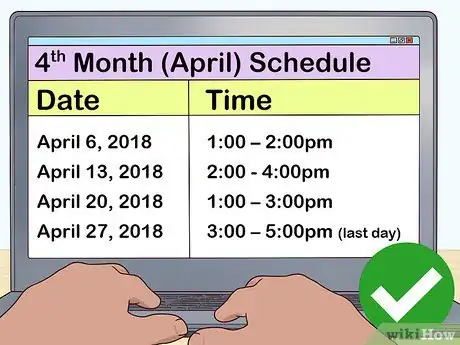This article was co-authored by wikiHow Staff. Our trained team of editors and researchers validate articles for accuracy and comprehensiveness. wikiHow's Content Management Team carefully monitors the work from our editorial staff to ensure that each article is backed by trusted research and meets our high quality standards.
This article has been viewed 18,441 times.
Learn more...
Teaching evangelism is a great opportunity to help others spread the message of Christ in a meaningful, impactful way. You may teach friends, family, or members of your congregation how to evangelize so they can convince and hopefully convert individuals into the faith. One way to teach evangelism is to do in-person training so participants get hands-on lessons. You can also use the Bible as a study guide to deepen your teaching. Encourage participants to put their evangelism training into practice and follow up with them to give them support or guidance as needed.
Steps
Doing In-Person Training
-
1Find participants in your congregation and social groups. Reach out to members of your congregation to ask them if they would like to learn more about teaching evangelism. Focus on new members and members who show an interest in deepening their faith so they can share it with others.
- You can also ask friends, family members, neighbors, coworkers, and peers at school if they’d like to learn how to evangelize.
-
2Set a clear start and end date for the training. Begin by outlining how long the teaching will be for the participants. You may start with a 3-4 month commitment where you meet for training once a week for 1-2 hours. You may also ask participants to set aside 1-2 hours a week for homework or home study.[1]
- Make sure the participants are comfortable with the start and end date for the training. Check that most, if not all the participants can attend every weekly meeting or training session.
Advertisement -
3Encourage participants to discuss their faith in Jesus. Open the training by inviting participants to share their personal feelings and experiences about their faith. Ask them to explain how they feel about Jesus and God. This will help set the tone for the training sessions and allow the participants to open up.[2]
- For example, you may say to participants, “I invite you now to share your experiences with Jesus” or “Would anyone like to express what their faith means to them?”
-
4Show participants how to be an active listener. A key aspect of evangelizing is being an attentive listener to others so you can make a connection with them. Explain the purpose of active listening and the importance of maintaining positive body language when you listen to others. Show them how to maintain eye contact and turn their body towards the person they are engaging with.[3]
- You may demonstrate active listening by asking a participant a question about their faith. You can then listen attentively, maintaining eye contact and nodding to show you are engaged. Avoid interrupting or cutting off the person as they are speaking.
- You can then respond with “What I hear you saying is…” or “I believe what you are saying is…”. Once the person agrees you have heard them correctly, you can respond to them in a respectful way.
-
5Teach participants how to ask thoughtful, probing questions about faith. Some of the people the participants will be evangelizing will have different ideas about faith and Jesus. Rather than shut these people out, participants should pose questions that are thoughtful and probing to start a dialogue. The questions should allow the person to express themselves and feel they are being treated with respect.[4]
- For example, you may have participants ask questions like, “Can you tell me how you view faith and Jesus?” “Can you tell me more about your beliefs?” or “Would you be open to exploring a different set of beliefs?”
-
6Have participants perform example situations to practice. Pair the participants together and have one person be the evangelist and the other person be the potential convert. Have the participants practice using active listening and probing questions to get a dialogue started.
- Ask the participants to switch roles after 5-10 minutes so they can experience both sides of the discussion.
- Have participants share any thoughts or reflections after the practice sessions with the larger group so everyone can learn from each other.
-
7Keep the training atmosphere open and inclusive. Ensure participants that the training session is a safe, open space where they can express themselves honestly. Remind them there is no single right way to evangelize and that the training sessions are a learning opportunity for everyone. Make sure participants feel comfortable in the sessions and included in the group discussion.[5]
Using the Bible as a Study Guide
-
1Discuss passages that address evangelism. A good way to reach a potential convert is to present Bible passages that they can read and work through. The participants should learn which Bible passages are good for evangelizing and how they can show others the value of the Bible through the passages. Bring in a few example passages that you feel are useful for reference when evangelizing.[6]
- For example, you may use passages from the Gospel that invite the reader to seek salvation in Jesus Christ, such as Luke 10:25-28, Matthew 4:17, or Matthew 11:28-30.
- You can also use passages from the Letters from Paul that focus on invitations to faith, such as Romans 10:9-10, Romans 10:13, and Acts 16:30- 31.
-
2Encourage participants to find passages that discuss evangelism. Have participants do a deep dive into the Bible to identify passages that they feel would be inviting to potential converts. Ask them to look at passages that explain the meaning of faith in a powerful way. Have participants discuss why they were drawn to a particular passage with the rest of the group so everyone can learn together.[7]
- You may assign this as homework for participants so they can spend some time reading and choosing passages.
-
3Have participants explain a passage in their own words. Encourage participants to find deeper meaning by asking them to express what the passage means to them. Have them explain the passage using their own language and understanding. This can help them better explain the passage to potential converts when they evangelize.[8]
- For example, you may ask participants, “What does the passage mean to you as a person of faith?” and “How would you explain the meaning of this passage to someone outside the faith?”
-
4Ask participants to pray on specific passages to find deeper meaning. Understanding the teachings of the Bible is crucial to learning how to evangelize effective. You may ask participants to take time in the session to pray on specific passages in the Bible so they can connect in a more meaningful way.[9]
- This may be a good way to wrap up a training session or open a training session to get participants focused on Biblical study.
Putting Evangelism into Practice
-
1Give participants booklets and material they can use to evangelize. Provide booklets that discuss the word of God and the teachings of Jesus that the participants can use with potential converts to spread their message. Make sure the booklets feature bright colors and attractive images so people are more likely to respond to them.[10]
- You can make your own evangelizing booklets or order them through your local Christian supply store in person or online.
-
2Have participants pay an evangelistic visit to a family member, friend, or peer. Once the participants have spend time learning how to evangelize, encourage them to put their lessons into practice by evangelizing those close to them. Encourage them to have one-on-one visits with family members or friends. Remind them to focus on being active listeners when they evangelize and to use the Bible as a reference.[11]
- Have participants do at least one evangelistic visit a month so they can put their skills into practice.
- You may include evangelistic visits at the very end of the training so the participants can work their way up to this goal or takeaway.
-
3Follow up with the participants regularly. Try to check in with participants at least once a month or several times a year to see how they are doing in their work as evangelists. Ask them if they feel they need additional training or support from you or others in the religious community. Let them know you are available if they have any questions or concerns about their evangelism.[12]
References
- ↑ https://wrs.edu/assets/docs/Journals/1995b/2-2%20Cover%20&%20Journal.pdf
- ↑ https://wrs.edu/assets/docs/Journals/1995b/2-2%20Cover%20&%20Journal.pdf
- ↑ http://www.ccel.org/contrib/exec_outlines/emp/emp_06.htm
- ↑ http://www.ccel.org/contrib/exec_outlines/emp/emp_06.htm
- ↑ http://www.ccel.org/contrib/exec_outlines/emp/emp_06.htm
- ↑ https://wrs.edu/assets/docs/Journals/1995b/2-2%20Cover%20&%20Journal.pdf
- ↑ https://wrs.edu/assets/docs/Journals/1995b/2-2%20Cover%20&%20Journal.pdf
- ↑ https://www.desiringgod.org/messages/the-church-and-evangelism
- ↑ https://www.desiringgod.org/messages/the-church-and-evangelism














-Step-8-Version-3.webp)

-Step-10.webp)

















-Step-8-Version-3.webp)

-Step-10.webp)



































